Abstract
The Ebinur Lake Basin is a typical terrestrial sedimentary Basin in Northwest China that has developed a piedmont distributive fluvial system (DFS) sedimentary environment, lake sedimentary environment, and desert sedimentary environment. The Ebinur Lake receives the sediments carried by the rivers in the basin and is the regional sedimentary center. In this study, a division scheme of modern sedimentary system tracts in the Ebinur Lake Basin was proposed. According to the landform, sedimentary environment, structure, and sedimentary system types, the Ebinur Lake Basin was divided into five system tracts. The area with high altitude and steep gradients mainly develops the rapid sedimentary system DFS, and the area with the lowest altitude in the region develops the lake sedimentary system. The main action area of climate drought and wind field is the dune sedimentary area. The wind field under the influence of hydrological climate and geomorphology has an important influence on the distribution of the sedimentary system tract. The structure determines the development of different types of sedimentary systems by controlling the topographic fluctuation and sedimentary space. Hydroclimate and geomorphology affect the development of sedimentary systems by controlling the sediment source rate in the sedimentary area. Based on the analysis of the characteristics and distribution of the modern sedimentary system in the Ebinur Lake Basin, a method for determining the level of the sedimentary system of the Ebinur Lake was established together with a plane model of the sedimentary system of the Ebinur Lake, which provides a reference for the study of the sedimentary system of continental basins.
1. Introduction
Modern sedimentary investigation is the basis for studying the sedimentary process, analyzing the sedimentary environment, and establishing the sedimentary facies model. Most of the existing sedimentary models are derived from the investigation of modern sedimentation. Through the study of modern rivers [1,2], river deltas [3,4], lakes [5], alluvial fans [6], and dunes [7,8], the study of sedimentary models is supported by a large amount of data. However, previous sedimentary model research mainly focused on the analysis of single sedimentary systems and single microfacies types, ignoring the interconnection between sedimentary systems within the basin. The prediction function of the sedimentary facies model established by this model is not strong, and it is difficult to adapt to the needs of deep and unconventional oil and gas exploration and development under the current high-cost and high-risk conditions. It is necessary to create a new, more predictive, and comprehensive sedimentary model [9].
The system tract refers to a series of sedimentary system assemblages formed in the same period [10]. This term comes from the field of sequence stratigraphy. Generally, within a sequence, it is divided into three system tracts according to the relative sea level position and its rising and falling trend at the time of its formation, namely, low-stand system tract (or continental shelf margin system tract), transgressive system tract, and high-stand system tract [11]. Subsequently, many scholars discussed in depth the types of sequence boundaries, put forward the concepts of forced regression system tract and descending (period) system tract, and suggested that the sequence architecture of the ‘three-division’ system tract should be revised to ‘four-division’; that is, descending system tract, low-stand system tract, transgressive system tract, and high-stand system tract [12,13,14]. With the continuous rise in research, the concept of sedimentary system tract is not only used in the field of sequence stratigraphy but also gradually evolved into a series of interrelated sedimentary systems in the plane or vertical combination, which is also widely used in continental deposits. Catuneanu et al., 2007 [15] analyzed the general cycle of accommodation space or sediment supply change according to the fine adjustment of sequence definition and extended the application of sequence stratigraphy to all sedimentary environments. Feng et al., 2000 [16] analyzed the sequence formation of the continental faulted basin. Wu et al., 2010 [17]. divided the system tracts into conventional system tracts and unconventional system tracts. The conventional system tracts refer to the common system tracts defined in classical sequence stratigraphy. The unconventional system tracts refer to all system tracts related to specific sedimentary environments outside the conventional system tracts, including the high-capacity space system tracts and low-capacity space system tracts in the alluvial fan-river sedimentary system, the forced regression system tracts in the coastal shallow sea under a gentle gradient background, the descending system tracts of the shallow sea-deep sea system under the continental shelf background, and the coastal shallow sea (lake) environment. In 2014, based on the concept of unconventional system tract, Mei [18] studied the sequence stratigraphic sequence of the coarse clastic rock series of the Gulanghekou Group in Gansu Province. The application of system tracts in continental sediments has promoted people’s further understanding of regional sedimentary systems and provided new ideas for studying the scope of sedimentary systems.
With the development of earth information science and technology, big data, and artificial intelligence technology, people can use remote sensing satellite images to obtain the characteristics of different sedimentary environments and sedimentary microfacies in large-scale sedimentary systems as well as the overall information about their relationships. It provides a new means for understanding the distribution of sedimentary systems and establishing a basin-wide sedimentary system prediction model. Weissmann et al., 2010 [19], and Hartley et al., 2010 [20] used Google Earth to count the alluvial river sedimentary systems in 724 modern sedimentary basins around the world, providing a new perspective for the sedimentary model of continental basins.
Although a large number of modern sedimentary systems have been investigated, the sedimentary analysis under the coexistence of multiple sedimentary systems in the basin is not enough. At present, only Mario et al. [21], Cavazza et al. [22], and Alessandro et al. [23] have been engaged in analyzing the modern sedimentary systems in the Pantanal wetland, the southern gradient of the Himalayas, and the southern side of the Alps in South America.
A large number of sedimentary systems with different forms and genesis have developed around the Ebinur Lake Basin, which constitute different sedimentary system tracts and provide good conditions for the study of sedimentary systems in the basin. The aim of this study was to put forward a suitable classification scheme of sedimentary system levels, establish a plane model of modern sedimentary systems in this area, analyze the relationship between different sedimentary systems, and provide data reference for the analysis and research of other continental basins, which also can be used as data support for the prediction of underground sedimentary systems.
2. Study Area
The Ebinur Lake is located in the southwest of the Junggar Basin in Xinjiang Uygur Autonomous Region (44°12′–45°15′N, 81°7′–84°56′E) (Figure 1a). It is a lake formed by the rifting of the Ebinur Lake-Xingxingxia fault zone with the Sax Lake and Ala Lake in Kazakhstan [24,25,26]. It is the largest saline lake in Xinjiang. The Ebinur Lake Basin spans Bortala Mongol Autonomous Prefecture, Shuanghe City, Wusu City, Kuitun City, and Karamay City. The area has sparse precipitation (89.8–169.7 mm/year) and large evaporation (1569–3421 mm/year). The annual average temperature is 7.8 °C, and the temperature difference during the year is large. It belongs to a typical temperate continental climate [27]. The northern side of the basin is the Zaire Mountains, the west is adjacent to the Alataw Mountains, and the south is bordered by the Yilianhabierga Mountains. The geological structure belongs to a part of the piedmont depression at the northern foot of the Tianshan Mountains. Controlled by the regional geological structure, the Quaternary paleogeographic evolution of the lake area is complex. The basin has continued to decline in the Quaternary period [28], and the surrounding mountains have risen, accumulating hugely thick Quaternary sediment (Figure 1b). The study area covers an area of 22,004 km2. The basin includes the Bortala River, Jinghe River, Guertu River, Sikeshu River, Kuitun River, and other rivers flowing through the area and the alluvial system in front of the mountains. Ebinur Lake is the catchment center of this area. The scope of the study area is shown in Figure 1.
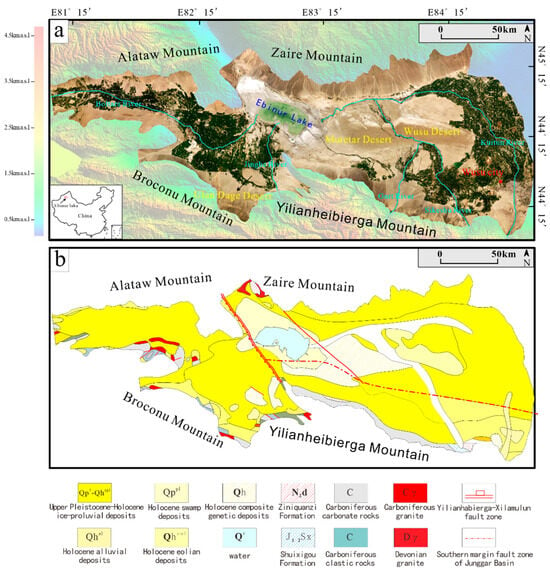
Figure 1.
(a). Geographic location of the Ebinur Lake watershed. 2024. (The basic map comes from Google Earth satellite images and Global Mapper elevation imagery). (b). Geological map of Ebinur Lake Basin. 2024. (From China Geological Archives).
3. Research Methods
In this study, the Ebinur Lake Basin was studied by satellite image interpretation and field sedimentary investigation. Satellite images can be used to observe the basin macroscopically, but the accuracy of sedimentary system identification is low. Therefore, field sedimentology can make up for this shortcoming. All the maps are made by Corel Draw 2021 on the basis of satellite images, elevation images and field photos.
3.1. Interpretation of Satellite Image
This data collection used the elevation data in Google Earth 2022 (7.3.3.7786) and Global Mapper 2021 (21.0.1) software to interpret the sedimentary system of the Ebinur Lake Basin. Combined with the polygon addition operation and profile elevation in Google Earth, SRTM Worldwide Elevation Date (1-arc-second Resolution, SRTM Plus V3) in Global Mapper online data, the sedimentary systems were divided up. In Google Earth, the point, line and surface attributes can be applied to measure the morphological characteristics of DFS, desert, and lake sedimentary systems. In this instance, the analysis section of Global Mapper was also used to generate contour maps.
The data collection of this study first draws each sedimentary system according to the Global Mapper elevation data (Figure 2a) and exports the kmz file of each sedimentary system to be displayed in the Google Earth satellite image (Figure 2b). Finally, the minimum elevation of the cross-section between different sedimentary systems in Google Earth (Figure 2c) further confirms the boundaries of each sedimentary system [29]. After drawing each sedimentary system, the data are extracted in Google Earth 2022 (7.3.3.7786) software. The basic data such as the area (A) and radius (r) of DFS, the wavelength (L) and width (W) of dunes, and the area of lakes can be directly obtained through Google Earth’s closed area. The DFS elevation change data (h1), the difference between the top and bottom elevations of the DFS radius and the gradient (G), is calculated using the DFS gradient calculation formula [30]. The height of the dune (h2) is the elevation difference between the highest point and the lowest point on the windward side of the dune (Figure 2d). Dune measurement sample selection divides the horizontal and vertical profiles in the desert area according to equal distance; two dunes are selected near the intersection of each horizontal and vertical profile for measurement (Figure 2e). A total of 121 DFS and 186 dunes were measured in this study, with a total of 1050 data. The measurement includes the determination of the sedimentary boundary of each sedimentary system and the statistics of the size of the morphological data. A total of 121 DFS and 186 dunes were measured, with a total of 1050 data.
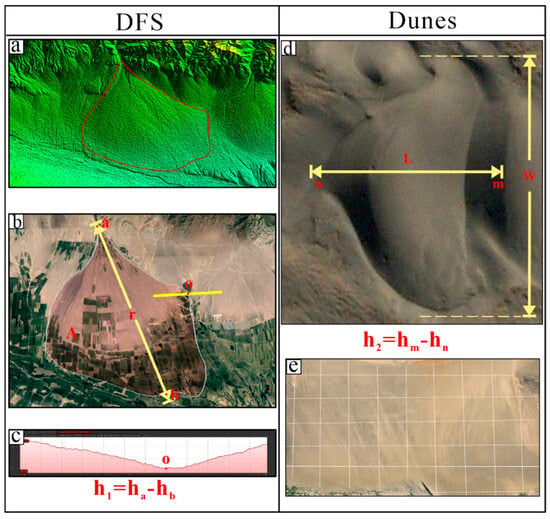
Figure 2.
Satellite image data measurement method, 2024. (The basic map comes from Google Earth and Global Mapper elevation imagery. (a) Preliminary sketch in Global mapper; (b) Import into Google Earth. (c) Boundaries are determined by the lowest point of elevation; (d) Dune measurement morphological data. (e) Desert cross-sectional division.).
3.2. Field Sedimentary Investigation
The equipment used in this field investigation is a drone DJI Air 2S equipped with an inch 20-million pixel image sensor. The UAV is used to record the various sedimentary systems in the basin, including the river channel type, sediment characteristics, and sedimentary environment, and to obtain high-precision and multi-angle image data. In addition, it can also improve the further research on the areas where the boundary of the sedimentary system is difficult to identify, and the type of the sedimentary system is difficult to confirm in the satellite image interpretation work.
4. Results
4.1. Types and Characteristics of Sedimentary Environment
The Ebinur Lake Basin is affected by the western circulation and Siberian cold air and has a typical temperate arid swamp desert ecosystem. The basin is surrounded by mountains on three sides. The Alataw Mountains in the west and the Yilinheibierga Mountains in the south are covered with snow all year round. The melted snow water provides a stable water source for some rivers in the basin. In addition, the Alataw Pass in the northwest of the basin is windy all year round, which disperses the sediment in the lake beach area of Ebinur Lake to other locations in the basin. Through satellite observation and field reconnaissance, it was determined that there are three main sedimentary environments in this area: lake sedimentary environment, desert sedimentary environment, and DFS sedimentary environment.
4.1.1. Lake Sedimentary Environment
The lake sedimentary environment of the Ebinur Lake Basin is mainly developed in the current Ebinur Lake area and its surroundings. The geographical location belongs to Tuotuo Township and Mangding Township in Jinghe County. It is formed by the confluence of various rivers and groundwater on the surface of the basin. The lake’s sedimentary environment area is 1906 km2. The lake sedimentary system, delta deposition, shore deposition, and shallow lake deposition are developed in the lake sedimentary environment area of Ebinur Lake.
The delta mainly includes the Bo River Delta (Figure 3a), the Jing River Delta (Figure 3b), the Kuitun River Delta, and a small river delta in the southeast. Through satellite images and field reconnaissance, it was proved that there are a large number of branch channels in the Bortala River and Jinghe River Delta. The sediments are mainly sandy, argillaceous, with a small amount of fine gravel sandy, and the interchannels are mainly argillaceous deposits. Affected by the arid climate and production from living water, a large number of branch channels in the Bortala River Delta have dried up (Figure 3c), and only the Jinghe River Delta still has river water flow (Figure 3d), providing water for Ebinur Lake.
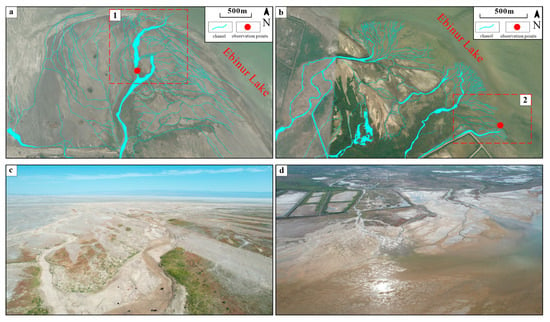
Figure 3.
Satellite images and field reconnaissance of the Bortala River and Jinghe River Delta, 2024. (a). Bortala River Delta; (b). Jinghe Delta; (c). Bortala River Delta 1 area field aerial photography (2023); (d). Jing River Delta 2 area field aerial photography (2023). Figures (a,b) were created on google earth imagery; Figures (c,d) are aerial photographs of the field (2023).
The shore deposits include the lake beach area at the edge of the current lake area of Ebinur Lake. The signs of multiple changes in the lake shoreline can be observed in the field (Figure 4). Regions I, II, and III are the latest three lake shoreline changes of Ebinur Lake. Region IV is the current location of the lake water of Ebinur Lake. Region I is the location of the lake shoreline during the flood period of Ebinur Lake, which is the highest lake shoreline currently visible. The sediments are mainly mud and silt, and the overall color is yellowish brown. Region II is the lake shoreline of Ebinur Lake in the normal water period. The main sediments are yellowish-brown silt. Due to the extremely high degree of salinization of the Ebinur Lake water and the very dry climate, a large number of white salt layers and mud cracks can be seen in the dry lake beach.
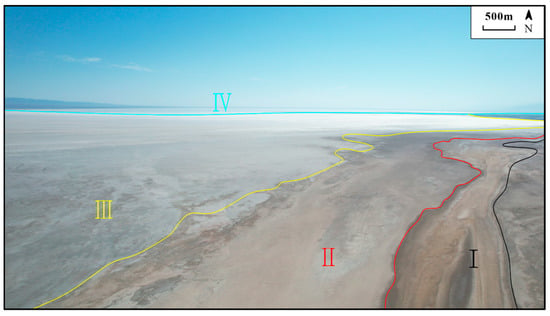
Figure 4.
Changes in the shoreline of Ebinur Lake at the entrance of Bortala fluvial to the lake, 2024. (Made from aerial photographs taken in the field 2023, I. The shoreline of the lake during floods; II. The shoreline of the lake during the flat water period; III. The shoreline of the lake during the dry season. IV. The shoreline of the lake during the inspection period.).
The water surface of Ebinur Lake is shallow lake sediments. The average water depth of Ebinur Lake is 1–2 m, and the lake area is about 480 km2. Under the images of arid climate and artificial water diversion and irrigation, the water source flowing into Ebinur Lake has been greatly reduced, the lake has been in a dry period for a long time, and the surface area of the lake has been reduced to area IV (Figure 4). During the evolution and development of Ebinur Lake, a large number of mineral ions were brought into the lake by the rivers and drainage channels. The salt has evaporated and concentrated on the lake surface and exists in the lake water with the rivers and drainage channels, which makes the salt content of the lake water increase continuously. Therefore, there are mainly high-salt muddy shallow lake sediments.
4.1.2. Desert Sedimentary Environment
The perennial drought, little rain, and strong wind in the study area provide good conditions for the formation of a desert sedimentary environment in the Ebinur Lake Basin. Ebinur Lake is located on the main channel of the strong wind in the Alataw Pass on the northwest side of the basin. The continuous, high-frequency, and strong winds have driven a large amount of sediment to the lake beach of Ebinur Lake and the lacustrine plain in the northeast of Jinghe County, and a desert sedimentary environment with an area of 1663 km2 has been formed in the basin. The northwest wind is the main wind direction in this area, so the windward surface of the dunes in the basin is mainly northwest and moves southeast. The desert sedimentary environment in the basin is distributed in Tuoli Town, Mangding Township, Tuotuo Township, and Wusu City of Jinghe County, mainly developing Ulan Dage Desert, Mutetal Desert, and Wusu Desert.
With the help of satellite images, the dune morphology developed in the desert sedimentary environment of the Ebinur Lake Basin was classified according to the morphology–dynamics principle of dunes. The classification includes two levels [31]. The first level is divided into transverse dunes, linear dunes, lattice dunes, and composite dunes according to the single sand transport wind direction, two-way sand transport wind, and multiple complex sand transport wind of dune dynamics. The second level is divided into eight types according to the main form of dunes, including star-moon dunes (Figure 5A), flat dunes such as star-moon dunes, asymmetric on both sides of the profile; the chain of star-moon dunes (Figure 5B) is formed by connecting the wing angles of two or more star-moon dunes. Seif sand dune (Figure 5C), the ridge of the sand dune is a more tortuous linear sand dune; linear dunes (Figure 5D) are elongated, with widths extending up to a few kilometers or even longer; grid-shaped dunes (Figure 5E), mainly formed by vertical wind interactions; trapezoidal lattice sand dunes (Figure 5D), the spacing ratio of main and auxiliary beams is quite different, almost orthogonal, forming a long lattice; honeycomb dunes (Figure 5G) are caused by wind in various directions and the wind is relatively balanced. The surface morphology is mainly characterized by an elliptical sand nest formed by low middle and no fixed direction sand stems around. The compound sand ridge (Figure 5H) is formed by the action of wind in multiple directions, and the shape is diverse and complex. According to Table 1, the wavelength range of the dunes is 45~738 m; the range of dune wave width is 63~922 m; the range of dune wave height is 63~922 m. The desert in the Ebinur Lake Basin is dominated by small-scale dunes.
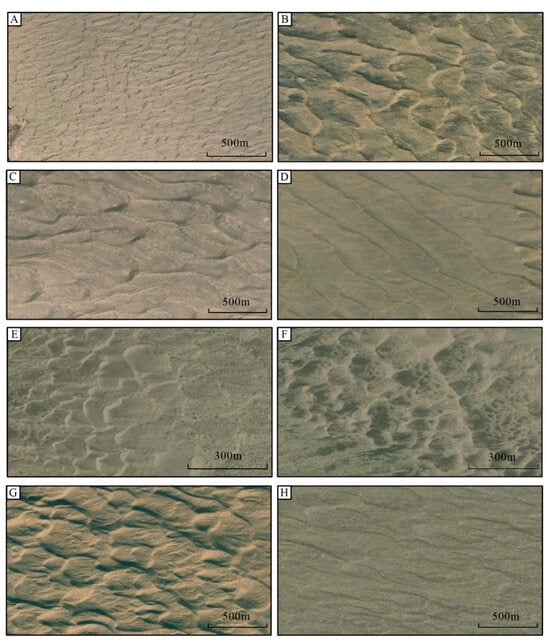
Figure 5.
Dune Types in the Ebinur Lake Basin, 2024. (A) Crescent dune, (B) Crescent dune chains, (C) Seif dune, (D) Linear sand dune, (E) Square lattice sand dunes, (F) Trapezoidal latticed dunes, (G) Honeycomb dunes, (H) Composite sand dune. The basic map comes from Google Earth satellite images.

Table 1.
Morphological characteristics of dune sedimentary system.
4.1.3. DFS Sedimentary Environment
The structural pattern and climatic conditions of the three sides of the Ebinur Lake Basin have formed a large-scale DFS sedimentary environment around the basin, which has developed from the front of the mountains on the edge to the center of the basin, accounting for 83.78% of the basin. The melting of snow on the southern and western mountain tops provides a stable water source for some rivers. With the continuous development of rivers, the expansion of diversion channels, and the leakage of groundwater, a large number of branch rivers have been formed. The northern Zaire Mountains are close to the Ebinur Lake, the sedimentary center of the basin, and the gradient is steep. The rapid growth of river runoff during the flood period leads to the bifurcation of levee.
According to the DFS classification scheme of Zhang Changmin et al. [32], the DFS system in this area is divided into three types: (1) Micro DFS, which is further divided into two types—with backbone river and revers. The micro DFS without a main river has a radius of less than 10 km, an area of less than 10 km2, and a gradient of more than 1.0° (Figure 6a); the geometry of micro DFS with main rivers is mainly fan-shaped, with a radius of 10~30 km, an area of 10~500 km2, and a gradient of 0.8~2° (Figure 6b). (2) Large-scale DFS, with a radius of 30~100 km, an area of 100~2000 km2, and a gradient of 0.3~2° (Figure 6c); (3) Macro DFS, radius greater than 100 km, the area more than 1000 km2, gradient less than 0.3° (Figure 6d). A total of 121 branch river sedimentary systems were developed in the Ebinur Lake Basin, including one macro DFS, four mega DFS, and 116 micro DFS, including 48 micro DFS with trunk rivers and 68 micro DFS without trunk rivers.

Figure 6.
DFS types and their main characteristics in the Ebinur Lake Basin. 2024. (The basic map comes from Google Earth satellite images).
The micro DFS with the main channel is concentrated in the front of the mountain, and the terrain is steep. It is concave from the top to the end, and it is low on both sides of the convex in the horizontal direction. The main channel is mainly braided river, and the distal end may develop a short-range meandering river. In addition, a large number of braided river channels have developed in the whole sedimentary system (Figure 7), most of which are straight gravel river channels. The sediments between the distributary channels are mainly sandy gravel, less muddy sediments, while the gravel beaches are widely developed. The flow of the river channel is affected by seasonality, and some of the continuous river flow can be seen. Most of the river channels are temporary channels, mainly due to debris flow deposits. The vegetation is sparsely developed, with mainly drought-resistant plants, mainly growing in the river edge area. The micro DFS without a main channel is developed in the steep area of the piedmont or between DFS. It is mainly composed of gravity flow deposits, without an obvious main channel. A large number of temporary gravel braided channels are distributed on the surface. The channel is dispersed from the near end to the far end (Figure 7), and the distance between adjacent channels gradually increases. The main sediments of this type of DFS are gravel, with a small amount of sand and mud, and almost no vegetation. Through the observation of satellite images, the micro DFS of non-trunk channels includes two types: inverted cone shape and fan shape. The former is mainly developed between DFS and is cut by DFS on both sides to form an inverted cone shape, while the latter is developed in the piedmont and is not affected by other sedimentary systems on both sides.
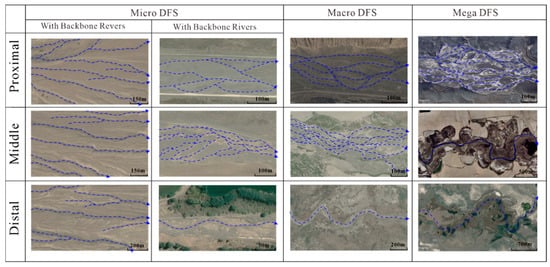
Figure 7.
Morphological transformation characteristics of different types of DFS rivers in the Ebinur Lake Basin. 2024. (Based on Google Earth satellite imagery).
Mega DFS mainly developed in the piedmont to the edge of the basin. From the top, the main channel is dominated by braided channel, the middle part is mainly braided-meandering channel conversion, and the distal part is small meandering channel (Figure 7). The width of the channel gradually decreases from the near end to the distal end. The proximal part of the large DFS is mainly dominated by river deposits, which are converted to flood plains from the middle to the distal end. Temporary lakes and wetlands can be seen in the flood plains. A small number of rivers are cut off to form oxbow lakes and a large number of plants are developed around them. Dunes are developed in arid and windy areas. The grain size change of large DFS is particularly obvious from the proximal to the distal end. The sediments located at the proximal end are mainly gravel, and the sand content increases to the middle, which is dominated by sand–gravel mixed sediments, while the distal end is dominated by sand–mud sediments, containing a small amount of fine gravel.
Macro DFS, with a large scale, occurs in the front of the mountain until the center of the basin. The average slope of the proximal end of the giant DFS is large, mainly composed of large gravel braided channel deposits (Figure 7), and the average slope of the middle and distal ends is reduced, while the middle deposits are mainly composed of sandy gravel. Banded sand bodies and gravel layers are visible, with more being mainly silty and muddy flood plains. The morphological changes of giant DFS rivers are diverse. The changes from the proximal end to the middle end of the river are similar to those of large DFS. The river channel in the distal area is often characterized by a single high-curvature small river channel. When the climate is dry and other systems are less integrated, the main river flows through the river. Due to the long distance, the degree of change in the slope of the river gradually decreases, the flow rate decreases, and the river will have phenomena such as cutoff and channel change, which make it easy to form large numbers of abandoned rivers and oxbow lakes.
According to Table 2, the radius range of DFS sedimentary system in Ebinur Lake Basin is 1.44~144 km, the area range is 0.45~2731 km2, and the slope range is 0.18~7.5; the Ebinur Lake basin is mainly dominated by micro DFS sedimentary system.

Table 2.
Morphological characteristics of DFS sedimentary system.
4.2. Sedimentary System Tract
In the early stage of the continental system tract, the conventional system tract division of the marine stratigraphic concept system was adopted. With the introduction and application of the unconventional system tract concept in recent years, the theory of continental system tract division has been continuously improved [33]. This study takes the sedimentary environment as the main standard, combined with the different regional landforms, sedimentary system types, regional structures, and provenance areas in the Ebinur Lake Basin; this area is divided into five system tracts (Figure 8), the southern system tract, the western system tract, the northern system tract, the lake system tract, and the desert system tract.
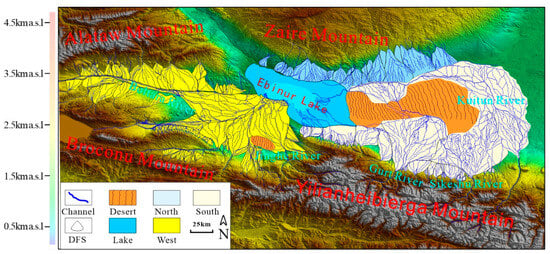
Figure 8.
Sedimentary system tract in the Ebinur Lake Basin. 2024. (Based on Global Mapper elevation imagery).
4.2.1. Southern System Tract
The southern system tract of the Ebinur Lake Basin is developed in front of the Yilianhabierga Mountain, which is the largest and most complex system tract in the Ebinur Lake Basin (Figure 9). The Kuitun River is the most important in this area, from south to north and finally to west into the Ebinur Lake. Many rivers in the front of the mountain, including the Sikeshu River and the Guertu River, eventually converge into the Kuitun River, forming a huge DFS containing the Kuitun River, the mega DFS of the Sikeshu River, the mega DFS of the Guertu River, and a series of micro DFS. A total of 67 DFS were developed in the southern system tract, including one macro DFS depositional system, two mega DFS depositional systems, 13 micro DFS with main rivers, and 51 micro DFS without main rivers. The micro DFS and DFS in the southern piedmont are mainly developed between the Guertu River, the Sikeshu River, and the Kuitun River, and a small amount of micro DFS is developed west of the Guertu River. Because the provenance area in the southern region is higher than that in the northern region, the DFS sedimentary system tracts in the southern DFS system tract are developed from south to north, and the vertical extension is wide and the scale is large. The area of mega DFS and macro DFS accounts for 78.1%, and the area of micro DFS accounts for 21.9%.
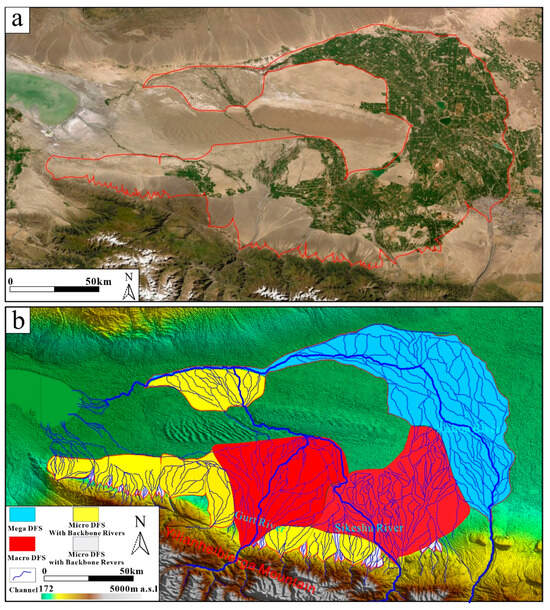
Figure 9.
Southern system tract. 2024. (a) Southern DFS system tract satellite images; (b) distribution of sedimentary system in Southern DFS system tract. Based on Global Mapper elevation imagery and Google Earth imagery.
4.2.2. Western System Tract
The western system tract (Figure 10) is located between the Alataw Mountains and the Borokonu Mountains. It has the topographic characteristics of three sides of the mountains and one side of the open trumpet-shaped valley. The area is 30.97% of the Ebinur Lake basin. The overall terrain of this area is high in the west and low in the east. A large number of rivers flow from the front of the mountain to the west to the east and finally flow into the Ebinur Lake. A total of 30 DFS sedimentary systems are developed in the western system tract, including two macro DFS and 28 micro DFS. There are 16 DFS with backbone river and 12 DFS with backbone revers in micro DFS types. The surrounding mountains of the western DFS system tract are complex, and the piedmont can accommodate less space, so there is no macro DFS. The main sedimentary systems are the mega DFS of the Bortala River and the mega DFS of the Jinghe River. The two mega DFS sedimentary systems account for 42.2% of the total area of the DFS system tract in the western part of Ebinur Lake.
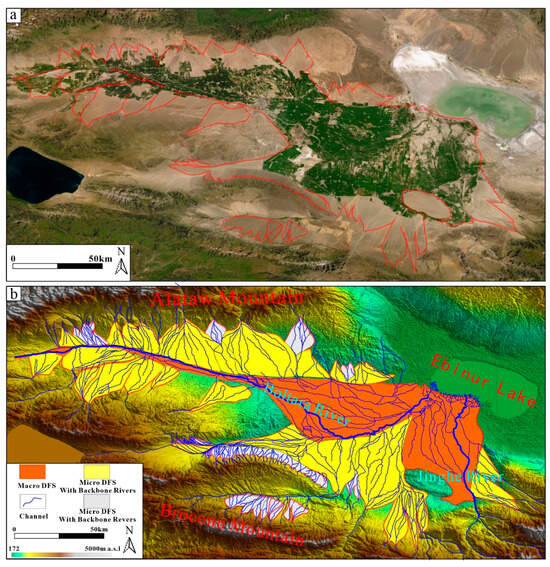
Figure 10.
Western system tract. (a) Western DFS system tract satellite images; (b) distribution of sedimentary system in western DFS system tract. Based on Global Mapper elevation imagery and Google Earth imagery.
4.2.3. Northern System Tract
The northern system tract (Figure 11) is located in the piedmont of the southern margin of the Zaire Mountains. The sedimentary system type is mainly the micro DFS system, and the entire system tract is distributed along the edge of the Kuitun River and the Ebinur Lake. The fan area in this system tract is 11.1~768 km2, the radius size is 6.64~36.3 km, and the gradient size is 0.75~1.88°. Compared with the southern and western system tracts, the sedimentary system type of the northern system tract is single. The main reason is that the source area of the northern system tract is lower in the Zaire Mountains and is close to the Ebinur Lake, the sedimentary center. The development space of the sedimentary system is small, so only micro DFS is developed. The northern system tract is bounded by Kuoertuobie. The DFS sedimentary system in the west terminates in the Ebinur Lake, and the DFS sedimentary system in the east terminates in the Kuitun River. This system tract develops 24 fans, including 19 micro DFS with trunk rivers and five DFS without trunk rivers.
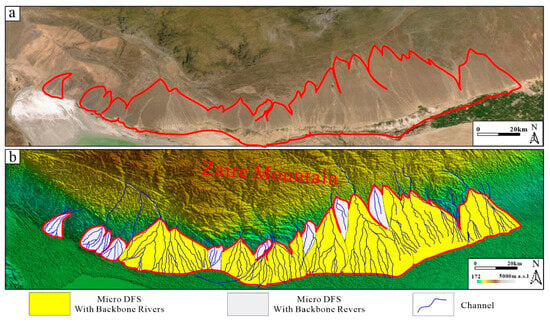
Figure 11.
Northern system tract. (a). Northern DFS system tract satellite images; (b). distribution of sedimentary system in northern DFS system tract. Based on Global Mapper elevation imagery and Google Earth imagery.
4.2.4. Desert System Tract
The development of the desert in the Ebinur Lake area began to develop in the late Pleistocene, which is closely related to the development of the arid environment in Xinjiang. The climate of the Ebinur Lake Basin is dry, and the annual average number of strong wind days can reach more than 164 days. The main wind field is the northwest wind of the Alashan Pass in the northwest. Therefore, the deserts in the modern Ebinur Lake Basin are mainly distributed in the Ulandan Dagai Desert in the south and the Muttar Desert and Usu Desert in the east (Figure 12). The Ulandandagai Desert is located in the western part of the Jinghe River. The wind field is affected by Broconu Mountain, and the large amount of sediment carried by the wind field is collected in this area, forming a large number of small-scale dunes. The Tumu Tetar Desert is located south of Guertu Town, west of Sikeshu River, and the Wusu Desert is located west of the Kuitun River. Under the strong action of the wind field of the Alashan Pass, many sand dunes of different sizes have been formed. The sand dunes in the middle of the desert are the largest and gradually decrease to the surrounding areas, and large-scale sand dunes and gullies can be seen in this area. The maximum elevation drop can reach 80 m and the width is 2 km. The Usu Desert is located in the northern part of Usu City. The wind field from the Alashan Pass is affected by the wind field in the Junggar Basin in this area, and the wind power is reduced. Therefore, the overall size of the dunes in the Usu Desert fluctuates less. The dunes in the Ulan Dage Desert are mainly crescent-shaped. The overall dune wavelength range is 90–319 m, the width is 148–473 m, and the dune height is 1–25 m. There are various types of dunes in the Mutetal Desert, including crescent-shaped dunes, compound dunes, seve dunes, trapezoidal lattice dunes, square lattice dunes, and honeycomb dunes. The size of dunes varies greatly. The wavelength range is 45–370 m, the width range is 63–450 m, and the height of dunes is 1–28 m. The overall size of the dunes in the Wusu Desert is relatively large, mainly sand ridges. The overall dune wavelength range is 101–384 m, the dune width is 128–586 m, and the dune height range is 1–39 m.
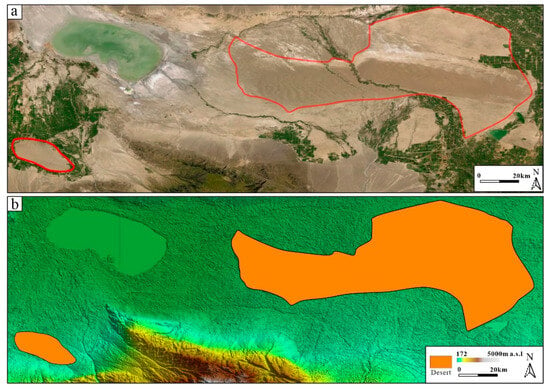
Figure 12.
Desert system tract. (a) Desert system tract satellite images; (b). desert system tract sedimentary system distribution. Based on Global Mapper elevation imagery and Google Earth imagery.
4.2.5. Lake System Tract
Ebinur Lake is located between Zaire Mountain, Jinghe County, and Bortala Island, which is the sedimentary center in the basin. It is the largest saltwater lake in Xinjiang, which is formed by the inflow of the Kuitun River, Sikeshu River, Guertu River, Jinghe River, Bortala River, Alataw Mountain, Mayili Mountain and is at the northern foot of Tianshan Mountain. The lake system tract includes the lake and beach area of Ebinur Lake (Figure 13), with a total circumference of 206 km and a total area of 1906 km2. The current lake water area has a circumference of 91.5 km and an area of 480 km2, accounting for 25.2% of the total area of the lake system tract. From the Pleistocene to the beginning of the last century, the lake surface of Ebinur Lake was reduced from about 3000 km2 to 1300 km2. Under the interaction of human activities, the lake’s surface has been reduced from 1300 km2 to 370 km2 since the beginning of the last century. The shrinking area after the lake water level drops has been transformed into swamps and salt marshes.

Figure 13.
Lake system tract. (a) Lake system tract satellite images; (b) lake system tract sedimentary system distribution. Based on Global mapper elevation imagery and Google Earth imagery.
4.3. Deposition Distribution and Control Factors
4.3.1. Distribution and Controlling Factors of Sedimentary System Tracts
The southern DFS system tract, the western DFS system tract, and the northern DFS system tract are located in the southern, western, and northern piedmont rapid sedimentary areas of the Ebinur Lake Basin, respectively. The lake system tract is located in the central sedimentary area in the northwest of the Ebinur Lake Basin. The desert sedimentary system tract is concentrated in the eastern and southern parts of the basin (Figure 14), which is the main area of wind field around the basin. The distribution of different sedimentary system tracts in Ebinur Lake is mainly affected by structure, provenance, hydrological climate, and wind field. The northern, southern, and western DFS system tracts are developed from the piedmont to the interior of the basin. The regional structure is complex, and the gradient is steep. The source area of the southern and western system tracts is large and the altitude is high. The melting of snow provides stable water conditions for the development of sedimentary systems in the system tracts. The source area of the northern DFS system tract is relatively small and there is no stable water supply. Therefore, the southern and western DFS system tracts are large, and the types of sedimentary systems are diverse. The regional terrain of the desert system tract is complex, and the elevation shows a phenomenon of repeated increase and decrease. The lake sedimentary system tract is the regional sedimentary center. The gradient of this area is gentle and unchanged, and it is the lowest elevation point in the basin. The rivers in the basin carry a large number of sources to gather here. The DFS system tract is formed in an area with complex structure and high terrain. When the terrain changes and repeatedly rises and falls, being located in the main action area of the wind field in the region, it becomes the desert system tract. The gentlest area in the region is easily the central area, and a large number of sediments are gathered here to form the lake sedimentary system tract. In addition, provenance, hydrological climate, and wind field affect the development scale of each system tract. When the provenance is sufficient, the climate is humid, and the wind field is large, the scale of the system tract is larger, and the scale of the conditional system tract is smaller.
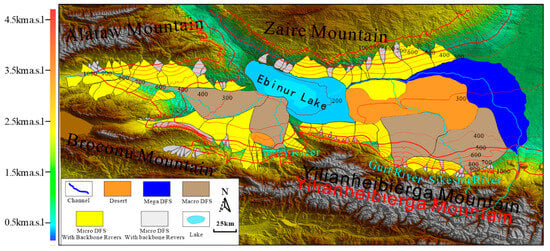
Figure 14.
Schematic diagram of contour lines and profiles in the Ebinur Lake Basin. 2024. (Based on Global mapper elevation imagery).
4.3.2. Distribution of Lake System and Its Controlling Factors
The Ebinur Lake system is located in the northwest of the Ebinur Lake Basin. After data analysis, the structure is the main controlling factor for the distribution of the lake system, while hydrological climate and human factors affect the development scale of the lake sedimentary system. The elevation contour map of the Ebinur Lake Basin shows the lowest elevation of the Ebinur Lake in this area. With the lake as the center, the DFS sedimentary system in front of the surrounding mountains provides the source for the sedimentary center, while the sediments carried by various rivers flow into this area. The climate of the Ebinur Lake Basin is dry, precipitation being less, while evaporation is large all year round. Under the condition of artificial water diversion, many rivers entering the lake dry up, and the lake surface scale of the Ebinur Lake is gradually shrinking. According to Google Earth statistics, the lake area was 526 km2 in 1984 and 370 km2 in 2020, with the lake area being seriously reduced (Figure 15). Therefore, the structure and provenance mainly control the geographical location of the formation of the lake sedimentary system, and the hydrological climate and human factors mainly affect the scale of the lake sedimentary system.

Figure 15.
Changes in Lake Ebinur from 1984 to 2020, 2024 (Based on Google Earth imagery).
4.3.3. Distribution and Controlling Factors of Dune Sedimentary System
A large number of dune deposits in the Ebinur Lake Basin are mainly due to the climate and wind field in the region. The Ebinur Lake Basin has a dry climate, perennial winds, and less plant development. At the same time, the lake beaches around Ebinur Lake and the Gurbantunggut Desert provide a large amount of material supply for the dune sedimentary system. The Ulandan Dagai Desert is located in a slightly higher area in this area. Under the same environment as the surrounding sedimentary system, it is easier to accumulate aeolian sand and form a desert. The Muttar Desert and the Wusu Desert are located in the area where the northwest trade wind of the Alashankou and the monsoon on the east side of Kuitun are combined, and a large amount of sediment is deposited in this area. Through the analysis of sand dune morphology data and frequency distribution, the size of sand dunes in the Ulandan Dagai Desert is uniform, and the size of dunes in the Muttar Desert and the Wusu Desert is significantly different, compared with the Muttar Desert. Therefore, the wind field is the main factor in the formation and scale of the desert. In addition, the structure and climate are the controlling factors of the dune sedimentary system.
4.3.4. DFS System Distribution and Its Controlling Factors
On the whole, the southern and western tectonic terrain of the Ebinur Lake Basin is higher, and the northern tectonic terrain is lower (Figure 14). Therefore, the number and type of DFS developed in the southern and western regions are more, and the scale gap is obvious. The size of the DFS in the north is relatively concentrated and the type is single. The high terrain in the south produces more accommodation space, forms more DFS, and can form large and macro DFS. The terrain structure in the west is complex, but the area is small, mainly developing micro DFS and mega DFS. Micro DFS is generally distributed in steep terrain areas. The source of the DFS system in the west and south is mainly from the melting of snow mountains. Under the stable source supply, the scale of DFS can be effectively expanded. The source of the north is from the Zaire Mountains, which is relatively scarce, and only in the flood period. The source provides more, so the scale of DFS is small and the gap is not large. Therefore, sufficient provenance can form a larger DFS system, and the scale of DFS with less provenance is small. By analyzing the data on river runoff [34,35,36,37,38], hydrology, and climate in the Ebinur Lake Basin (Figure 16), it is found that the larger the river runoff, the larger is the vertical scale of DFS. On the contrary, the smaller the runoff, the smaller is the corresponding vertical scale of DFS.
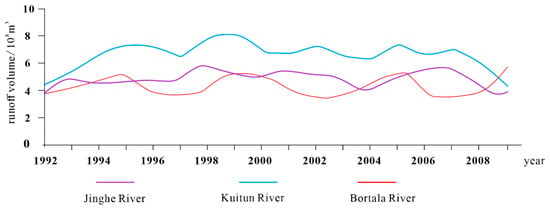
Figure 16.
Annual runoff characteristics of Jinghe River, Kuitun River, and Bortala River Basin, 2024 [34,35,36,37,38].
5. Discussion
After data analysis (Table 3), the DFS sedimentary system is the largest sedimentary system in the basin, exceeding 80% of the study area. The contact styles of different sedimentary systems in the basin can be divided into three types, including the smaller DFS terminated at the larger DFS boundary, and the DFS terminated at the three contact styles of lakes and deserts. The small DFS terminated in the large DFS contact style is developed in the eastern, western, and southern sedimentary system tracts of the basin. The DFS terminated in the lake contact style is mainly developed in the western and northern sedimentary system tracts centered on the Ebinur Lake. The DFS terminated in the desert contact pattern is mainly distributed in the southern system tract of the basin. The study area is mostly terminated by a small DFS at a large DFS contact style position (Figure 17).

Table 3.
The total area of different sedimentary systems and their proportion in the study area (On the basis of Google Earth satellite image attributes).
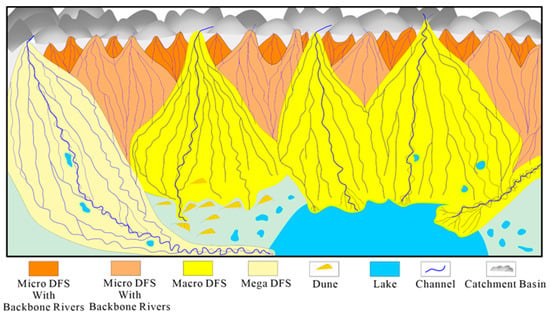
Figure 17.
Plane model of Ebinur Lake Basin sedimentary system, 2024.
This paper provides a multi-contact style systematic land basin sedimentary system planar depositional model dominated by the DFS sedimentary system. The sedimentary center of the basin is a lake sedimentary system, and a large number of wind-formed dune sedimentary systems are developed in the interior. The DFS sedimentary system is located in the premontane area around the basin, and it is also the largest type of sedimentary system in the basin. This kind of sedimentary model systematically characterizes the relationship between various sedimentary systems in the basin based on DFS, and there is a certain fluidity in the different adjacent DFS rivers. The sediments in the small DFS flow into the large DFS and the giant DFS with the river. When the hydrodynamic force is strong enough, the sediments will eventually flow into the sedimentary center of the basin. When the hydrodynamic force is weak, they will be deposited in the current DFS sedimentary system or deposited in the nearby desert.
6. Conclusions
In this paper, a method of systematic analysis and research on the basin according to the sedimentary environment and sedimentary system combination was proposed. The sedimentary system type is divided by the sedimentary environment, which is the first level of the basin analysis. The system domain is divided by different sedimentary system combinations, which is the second level of the basin analysis. By analogy, the systematic analysis of the basin is completed. This method can provide data reference for the analysis of continental sedimentary basins. The DFS-based multi-contact style basin sedimentary model provides a systematic new idea for basin research. Through the DFS sedimentary system, multiple sedimentary systems in the basin are connected to each other to form an aggregate of continuous sediments.
In this study, two levels of analysis were carried out on the Ebinur Lake Basin. The first level of analysis was divided into lake sedimentary environment, desert sedimentary environment, and DFS sedimentary environment, among which DFS sedimentary environment accounted for the largest area of the basin. The second-level analysis included five sedimentary system tracts, and a variety of sedimentary system tracts were combined to form the Ebinur Lake Basin.
The structure is the main controlling factor for the development of the sedimentary system in the Ebinur Lake Basin. The structure directly controls the development of the sedimentary system by controlling the sedimentary space and the rise and fall of the terrain. The terrain of the Ebinur Lake Basin is high in the south and low in the north. The southern region has higher sedimentary space and is the main development area of large sedimentary systems. The northern part is dominated by small sedimentary systems, and the western part is located between mountains. The region is small but the terrain changes rapidly, and various scales of sedimentary systems are developed. Other factors, such as hydrological climate, are auxiliary control factors, which are mainly manifested in the fact that hydrological climate and other factors can change the development scale of the sedimentary system controlled by the deposition rate of sediments.
The relationship between the sedimentary systems in the Ebinur Lake Basin is mainly manifested in a large number of different types of DFS contact patterns and DFS contact patterns with lakes and deserts. The contact patterns of the sedimentary system are mainly formed by the change of river hydrodynamics.
Author Contributions
Writing—original draft, J.X.; Analysis, Validation, Data Processing, Graphical Processing, J.X. and J.L.; Investigation, Q.M., X.L. and Y.Z.; Conceptualization, Supervision, Review, X.Z. All authors have read and agreed to the published version of the manuscript.
Funding
This research received no external funding.
Institutional Review Board Statement
Not applicable.
Informed Consent Statement
Not applicable.
Data Availability Statement
All data and materials are available on request from the corresponding author. The data are not publicly available due to ongoing research using a part of the data.
Conflicts of Interest
The authors declare no conflict of interest.
References
- Knebel, H.J. Modern sedimentary environments in a large tidal estuary, Delaware Bay. Mar. Geol. 1989, 86, 119–136. [Google Scholar] [CrossRef]
- Reddad, H.; El Talibi, H.; Perri, F.; El Moussaoui, S.; Zerdeb, M.A.; Zaghloul, M.N.; Critelli, S. Textural and compositional controls on modern fluvial and beach sands of Mediterranean coastal Rif belt (Northern Rif, Morocco). Ital. J. Geosci. 2016, 135, 336–349. [Google Scholar] [CrossRef]
- Szczuciński, W.; Jagodziński, R.; Hanebuth, T.J.; Stattegger, K.; Wetzel, A.; Mitręga, M.; Unverricht, D.; Van Phach, P. Modern sedimentation and sediment dispersal pattern on the continental shelf off the Mekong River delta, South China Sea. Glob. Planet. Chang. 2013, 110, 195–213. [Google Scholar] [CrossRef]
- Zhou, H.; Yuan, X.; Zhang, Y.; Dong, W.; Liu, S. Growth pattern research on the modern deposition of Ganjiang delta in Poyang lake basin by spatio-temporal remote sensing images. IOP Conf. 2016, 46, 012034. [Google Scholar] [CrossRef]
- Zhang, C.M.; Guo, X.G.; Liu, S.; Zhang, X.H.; Wang, X.L.; Guo, X.G.; Pan, J.; Hu, W.; Zhang, B.J.; Huang, R.X.; et al. Distribution of sedimentary environment and sedimentary system on the shore of modern Ulungu Lake and its controlling factors. Quat. Sci. 2020, 40, 49–68. [Google Scholar]
- Blair, T.C.; McPherson, J.G. Alluvial Fans and Their Natural Distinction from Rivers Based on Morphology, Hydraulic Processes, Sedimentary Processes, and Facies Assemblages. J. Sediment. Res. 1994, 64, 450–489. [Google Scholar]
- Jia, T.F.; Yin, S. Holocene geomorphological evolution in the northern Ulan Buh Desert. Geogr. Sci. 2004, 2, 217–221. [Google Scholar]
- Wang, M.; Gao, X.; Qu, X.; Zhang, S.; Zhang, Y.; Chen, G.; Li, J. Morphological characteristics of dunes in the piedmont dunes of the southwestern margin of the Qaidam Basin. China Desert 2021, 41, 166–174. [Google Scholar]
- Changmin, Z.; Xinmin, S.; Dongming, Z.; Xinhuai, Z.; Taiju, Y.; Yanshu, Y.; Rui, Z.; Wenjie, F.; Baojin, Z. Rethinking on the sedimentary system of terrestrial petroliferous basins: Insights from distributive fluvial system. Acta Pet. Sin. 2020, 41, 127–153. [Google Scholar]
- Brown, L.F.; Fisher, W. Seismic-Stratigraphic Interpretation of Depositional Systems: Examples from Brazilian Rift and Pull-Apart Basins: Section 2. In Application of Seismic Reflection Configureuration to Stratigraphic Interpretation; Datapages Inc.: Rockaway, NJ, USA, 1977. [Google Scholar]
- Vail, P.R. Seismic stratigraphy and global changes of sea level. Mem. Am. Assoc. Pet. Geol. 1977, 26, 49–50. [Google Scholar]
- Posamentier, H.W.; Allen, G.P.; James, D.P.; Tesson, M. Forced regressions in a sequence stratigraphic framework: Concepts, examples, and exploration significance. AAPG Bull. 1992, 76, 1687–1709. [Google Scholar]
- Hunt, D.; Tucker, M.E. Stranded parasequences and the forced regressive wedge systems tract: Deposition during base-level fall. Sediment. Geol. 1992, 81, 219–230. [Google Scholar] [CrossRef]
- Helland-Hansen, W.; Gjelberg, J.G. Conceptual basis and variability in sequence stratigraphy: A different perspective. Sediment. Geol. 1994, 92, 31–52. [Google Scholar] [CrossRef]
- Catuneanu, O. Principles of Sequence Stratigraphy; Elsevier: Amsterdam, The Netherlands, 2007. [Google Scholar]
- Feng, Y.L.; Li, S.T.; Xie, X.N. Dynamics of sequence generation and sequence stratigraphic model in continental rift subsidence basin. Geol. Front. 2000, 3, 119–132. [Google Scholar]
- Wu, Y.; Zhang, T.; Zhang, Z.; Cui, H. Types and characteristics of depositional systems tract and its petroleum geological significance. J. Palaeogeogr. 2010, 12, 69–81. [Google Scholar]
- Mei, M.X.; Su, D.C. Sequence-Stratigraphic Succession for the Course Clastic Rock System of the Hekou Group in the Gulang County of Gansu Province: Sedimentological Response to Cretaceous Uplift of the Qilian Mountains. Geol. Rev. 2014, 60, 541–554. [Google Scholar]
- Weissmann, G.; Hartley, A.; Nichols, G.; Scuderi, L.; Olson, M.; Buehler, H.; Banteah, R. Fluvial form in modern continental sedimentary basins: Distributive fluvial systems. Geology 2010, 38, 39–42. [Google Scholar] [CrossRef]
- Hartley, A.J.; Weissmann, G.S.; Nichols, G.J.; Warwick, G.L. Large Distributive Fluvial Systems: Characteristics, Distribution, and Controls on Development. J. Sediment. Res. 2016, 80, 167–183. [Google Scholar] [CrossRef]
- Assine, M.L.; Merino, E.R.; Pupim, F.D.N.; Macedo, H.d.A.; dos Santos, M.G.M. The Quaternary alluvial systems tract of the Pantanal Basin, Brazil. Braz. J. Geol. 2017, 45, 475–489. [Google Scholar] [CrossRef]
- Cavazza, D.C. A comparison of fluvial megafans in the Cordilleran (Upper Cretaceous) and modern Himalayan foreland basin systems. GSA Bull. 1999, 111, 1315–1334. [Google Scholar]
- Fontana, A.; Mozzi, P.; Marchetti, M. Alluvial fans and megafans along the southern side of the Alps. Sediment. Geol. 2014, 301, 150–171. [Google Scholar] [CrossRef]
- Yan, S.; Mu, G.J.; Nobuhiko, H.; Masao, U.; Naomi, H. Environmental Evolution Information from Aiby Lake since the Last 2500a. Arid. Land Geogr. 2003, 26, 227–231. [Google Scholar]
- Yan, S. Environmental evolution and countermeasures in Ebinur Lake and its surrounding areas. J. Arid. Land Resour. Environ. 1996, 1, 30–37. [Google Scholar]
- Bo, C.G.; Mu, G.J. The lakeshore landform of Ebinur Lake and its reflected lake surface change. Arid. Land Geogr. 1999, 34–40. [Google Scholar]
- Ding, J.L.; Ge, X.Y.; Wang, J.Z. Ebinur Lake wetland identification and its spatio-temporal dynamic changes. J. Nat. Resour. 2021, 36, 1949–1963. [Google Scholar] [CrossRef]
- Amantai, N.; Ding, J.; Ge, X.; Bao, Q. Variation characteristics of actual evapotranspiration and meteorological elements in the Ebinur Lake basin from 1960 to 2017. Acta Geogr. Sin. 2021, 76, 1177–1192. [Google Scholar]
- Lawton, T.F.; Schellenbach, W.L.; Nugent, A.E. Late Cretaceous Fluvial-Megafan and Axial-River Systems in the Southern Cordilleran Foreland Basin: Drip Tank Member of Straight Cliffs Formation and Adjacent Strata, Southern Utah, U.S.A. J. Sediment. Res. 2014, 84, 407–434. [Google Scholar] [CrossRef]
- Gulliford, A.R.; Flint, S.S.; Hodgson, D.M. Crevasse splay processes and deposits in an ancient distributive fluvial system: The lower Beaufort Group, South Africa. Sediment. Geol. 2017, 358, 1–18. [Google Scholar] [CrossRef]
- Wu, Z. Discussion on the Causes of Taklimakan Desert. Acta Geogr. Sin. 1981, 280–291. [Google Scholar]
- Zhang, C.; Zhang, X.; Hartley, A. On classification of distributive fluvial system. Lithol. Reserv. 2023, 35, 1–15. [Google Scholar]
- Bilmes, A.; Veiga, G.D. Linking mid-scale distributive fluvial systems to drainage basin area: Geomorphological and sedimentological evidence from the endorheic Gastre Basin, Argentina. Geol. Soc. Lond. Spec. Publ. 2016, 440, 265–279. [Google Scholar] [CrossRef]
- Yao, Y.; Mei, C.J. The composition of “unconventional” system tracts within the continental sequence: An important advancement on sequence stratigraphy. J. Palaeogeogr. 2017, 19, 513–524. [Google Scholar]
- Lei, M.; Zhou, J.L.; Zhang, J.; Chen, Y.P.; Teng, J.; Wu, T.; Xu, D.S.; Ji, Y.Y. Hydrochemical characteristics and transformation relationship of surface water and groundwater in the Plain Area of Bortala River Basin, Xinjiang. Environ. Sci. 2022, 43, 1873–1884. [Google Scholar]
- Shen, R.X.; Lv, S.P.; Du, M.L. Analysis of groundwater resources evolution in the plains of Kuytun River Basin. Arid. Zone Res. 2020, 37, 839–846. [Google Scholar]
- Dong, Y.; Zhang, L.S.; Chen, X.G. Runoff characteristic and its responses to precipitation change in Jinghe River. South-to-North Water Transf. Water Sci. Technol. 2016, 14, 60–64+98. [Google Scholar]
- Aji, D.N.; Kondo, H.; Aji, S. Climatic Change in the Bortala River Basin and Runoff Volume. Resour. Sci. 2014, 36, 2123–2130. [Google Scholar]
Disclaimer/Publisher’s Note: The statements, opinions and data contained in all publications are solely those of the individual author(s) and contributor(s) and not of MDPI and/or the editor(s). MDPI and/or the editor(s) disclaim responsibility for any injury to people or property resulting from any ideas, methods, instructions or products referred to in the content. |
© 2024 by the authors. Licensee MDPI, Basel, Switzerland. This article is an open access article distributed under the terms and conditions of the Creative Commons Attribution (CC BY) license (https://creativecommons.org/licenses/by/4.0/).